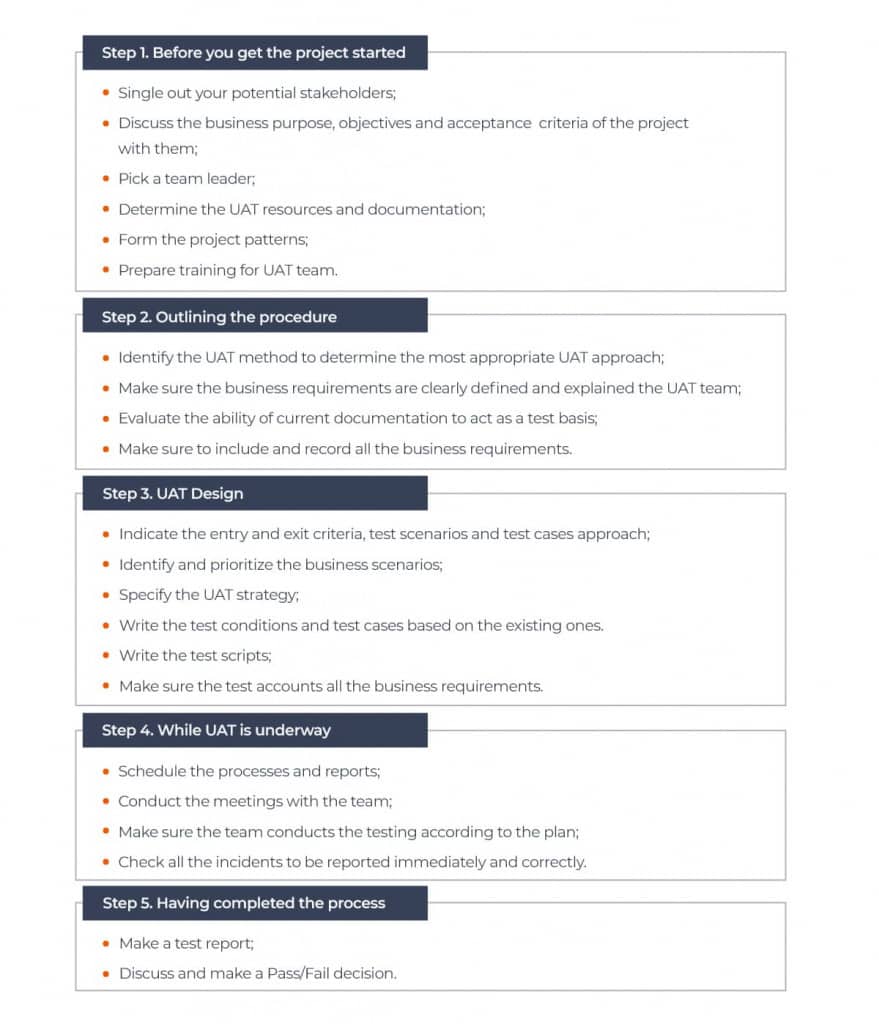- QATestLab Blog >
- QA Basics >
- User Acceptance Testing Checklist: Upgrade Your Testing Process
User Acceptance Testing Checklist: Upgrade Your Testing Process

Performing the User Acceptance Testing is the crucial step towards the real expectations of your target customers. This article suggests the User Acceptance Testing Plan one should take into account to avoid testing pitfalls.
User Acceptance Testing (UAT) is the last stage in the whole software testing cycle performed after the functional, integration, and system testing. The other names are end-user or beta testing. It presupposes the program being tested by the target software users. They have to verify the software system before its placement into the real conditions.
Why is User Acceptance Testing necessary?
The reasons why UAT is essential are:
- It is an integral part of the software testing process, performing this type, developers may find failures, not previously mentioned or considered acceptable.
- In order to keep up with the market trends companies should take into account the requirements of their target users. Targeting is a global tendency nowadays.
- Developers design the product from their point of view. They imply their interpretation of the customers’ requirements but they may not be aware of the customers` real interpretation.
- Users requirements are very unpredictable and sometimes due to the lack of communication between the developers and users, they may not be taken into account.
As a result, a brand-new product may be unsuitable or outdated. But UAT can solve all these problems.
A Guidebook to User Acceptance Testing
Performing the effective UAT is a time-consuming and challenging task for the testers. A systematic checklist is a key. The well-structured checklist includes such stages:

Step 1. Before you get the project started
If you have to keep in mind too many things to be done and you don’t know what to do first, here are the preparation stages. A thoroughly conducted first stage helps to avoid problems in the future.
- Single out your potential stakeholders;
- Discuss the business purpose, objectives and acceptance criteria of the project with them;
- Pick a team leader;
- Determine the UAT resources and documentation;
- Form the project patterns;
- Prepare training for UAT team.
Step 2. Outlining the procedure
Make a draft taking into account all the information gathered on the first stage. Adjust the testing to your peculiar case. This will assist in formulating the final results.
- Identify the UAT method to determine the most appropriate UAT approach;
- Make sure the business requirements are clearly defined and explained the UAT team;
- Evaluate the ability of current documentation to act as a test basis;
- Make sure to include and record all the business requirements.
Step 3. UAT Design
Specify the testing points and check all the previous stages to be delivered correctly. If the team clearly understands the task, this is the key to meet the stakeholders` requirements.
- Indicate the entry and exit criteria, test scenarios and test cases approach;
- Identify and prioritize the business scenarios;
- Specify the UAT strategy;
- Write the test conditions and test cases based on the existing ones.
- Write the test scripts;
- Make sure the test accounts all the business requirements.
Step 4. While UAT is underway
Detailed preparation is important but everything may go wrong during the process itself. The project needs 24/7 tweaking to control all the stages.
- Schedule the processes and reports;
- Conduct the meetings with the team;
- Make sure the team conducts the testing according to the plan;
- Check all the incidents to be reported immediately and correctly.
Step 5. Having completed the process
You shouldn`t omit the final stage and prepare a clear and exhaustive report. It is important for making a final decision about the testing.
- Make a test report;
- Discuss and make a Pass/Fail decision.
To sum it up
Conducting such a process as UAT is a long-running and demanding process. It is impossible to keep in mind all the points. To conduct high-quality testing you should have a detailed list. In the case if you miss something, no matter what stage it belongs to, it may be timely and challenging to make things right.
Learn more from QATestLab
Related Posts:
- Acceptance Testing: How to Predict a Real-life Experience
- Alpha Testing vs Beta Testing
- Why Should One Participate in Beta Testing?
About Article Author
view more articles







No Comments Yet!
You can be the one to start a conversation.